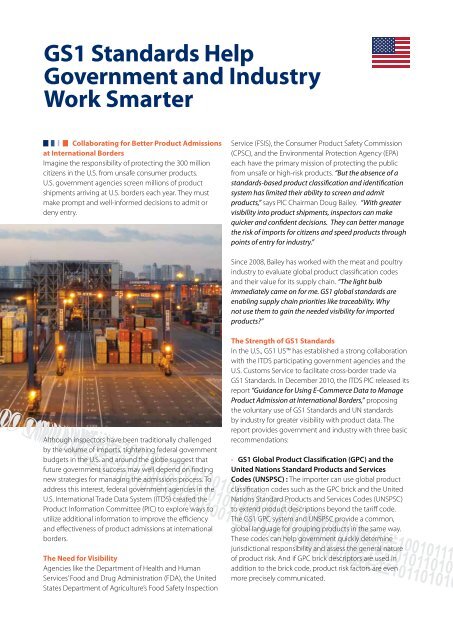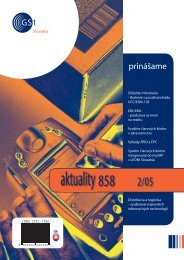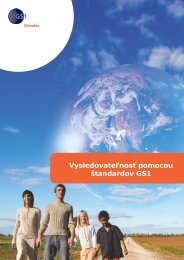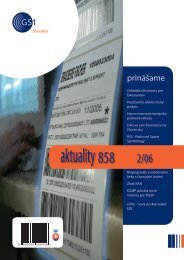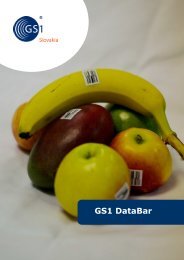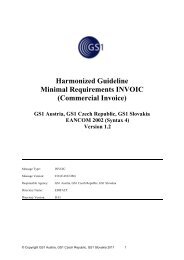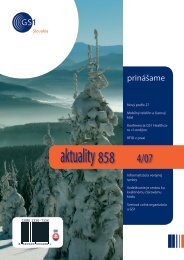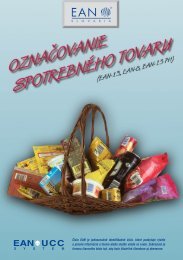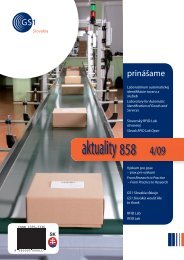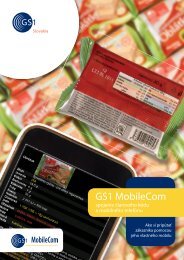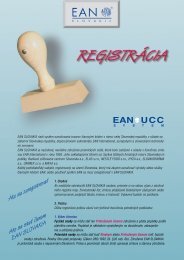GS1 StandardS in tranSport, LoGiSticS and cuStomS - GS1 Slovakia
GS1 StandardS in tranSport, LoGiSticS and cuStomS - GS1 Slovakia
GS1 StandardS in tranSport, LoGiSticS and cuStomS - GS1 Slovakia
Create successful ePaper yourself
Turn your PDF publications into a flip-book with our unique Google optimized e-Paper software.
<strong>GS1</strong> St<strong>and</strong>ards Help<br />
Government <strong>and</strong> Industry<br />
Work Smarter<br />
Collaborat<strong>in</strong>g for Better Product Admissions<br />
at International Borders<br />
Imag<strong>in</strong>e the responsibility of protect<strong>in</strong>g the 300 million<br />
citizens <strong>in</strong> the U.S. from unsafe consumer products.<br />
U.S. government agencies screen millions of product<br />
shipments arriv<strong>in</strong>g at U.S. borders each year. They must<br />
make prompt <strong>and</strong> well-<strong>in</strong>formed decisions to admit or<br />
deny entry.<br />
Service (FSIS), the Consumer Product Safety Commission<br />
(CPSC), <strong>and</strong> the Environmental Protection Agency (EPA)<br />
each have the primary mission of protect<strong>in</strong>g the public<br />
from unsafe or high-risk products. “But the absence of a<br />
st<strong>and</strong>ards-based product classification <strong>and</strong> identification<br />
system has limited their ability to screen <strong>and</strong> admit<br />
products,” says PIC Chairman Doug Bailey. “With greater<br />
visibility <strong>in</strong>to product shipments, <strong>in</strong>spectors can make<br />
quicker <strong>and</strong> confident decisions. They can better manage<br />
the risk of imports for citizens <strong>and</strong> speed products through<br />
po<strong>in</strong>ts of entry for <strong>in</strong>dustry.”<br />
S<strong>in</strong>ce 2008, Bailey has worked with the meat <strong>and</strong> poultry<br />
<strong>in</strong>dustry to evaluate global product classification codes<br />
<strong>and</strong> their value for its supply cha<strong>in</strong>. “The light bulb<br />
immediately came on for me. <strong>GS1</strong> global st<strong>and</strong>ards are<br />
enabl<strong>in</strong>g supply cha<strong>in</strong> priorities like traceability. Why<br />
not use them to ga<strong>in</strong> the needed visibility for imported<br />
products?”<br />
Although <strong>in</strong>spectors have been traditionally challenged<br />
by the volume of imports, tighten<strong>in</strong>g federal government<br />
budgets <strong>in</strong> the U.S. <strong>and</strong> around the globe suggest that<br />
future government success may well depend on f<strong>in</strong>d<strong>in</strong>g<br />
new strategies for manag<strong>in</strong>g the admissions process. To<br />
address this <strong>in</strong>terest, federal government agencies <strong>in</strong> the<br />
U.S. International Trade Data System (ITDS) created the<br />
Product Information Committee (PIC) to explore ways to<br />
utilize additional <strong>in</strong>formation to improve the efficiency<br />
<strong>and</strong> effectiveness of product admissions at <strong>in</strong>ternational<br />
borders.<br />
The Need for Visibility<br />
Agencies like the Department of Health <strong>and</strong> Human<br />
Services’ Food <strong>and</strong> Drug Adm<strong>in</strong>istration (FDA), the United<br />
States Department of Agriculture’s Food Safety Inspection<br />
The Strength of <strong>GS1</strong> St<strong>and</strong>ards<br />
In the U.S., <strong>GS1</strong> US has established a strong collaboration<br />
with the ITDS participat<strong>in</strong>g government agencies <strong>and</strong> the<br />
U.S. Customs Service to facilitate cross-border trade via<br />
<strong>GS1</strong> St<strong>and</strong>ards. In December 2010, the ITDS PIC released its<br />
report “Guidance for Us<strong>in</strong>g E-Commerce Data to Manage<br />
Product Admission at International Borders,” propos<strong>in</strong>g<br />
the voluntary use of <strong>GS1</strong> St<strong>and</strong>ards <strong>and</strong> UN st<strong>and</strong>ards<br />
by <strong>in</strong>dustry for greater visibility with product data. The<br />
report provides government <strong>and</strong> <strong>in</strong>dustry with three basic<br />
recommendations:<br />
• <strong>GS1</strong> Global Product Classification (GPC) <strong>and</strong> the<br />
United Nations St<strong>and</strong>ard Products <strong>and</strong> Services<br />
Codes (UNSPSC) : The importer can use global product<br />
classification codes such as the GPC brick <strong>and</strong> the United<br />
Nations St<strong>and</strong>ard Products <strong>and</strong> Services Codes (UNSPSC)<br />
to extend product descriptions beyond the tariff code.<br />
The <strong>GS1</strong> GPC system <strong>and</strong> UNSPSC provide a common,<br />
global language for group<strong>in</strong>g products <strong>in</strong> the same way.<br />
These codes can help government quickly determ<strong>in</strong>e<br />
jurisdictional responsibility <strong>and</strong> assess the general nature<br />
of product risk. And if GPC brick descriptors are used <strong>in</strong><br />
addition to the brick code, product risk factors are even<br />
more precisely communicated.


